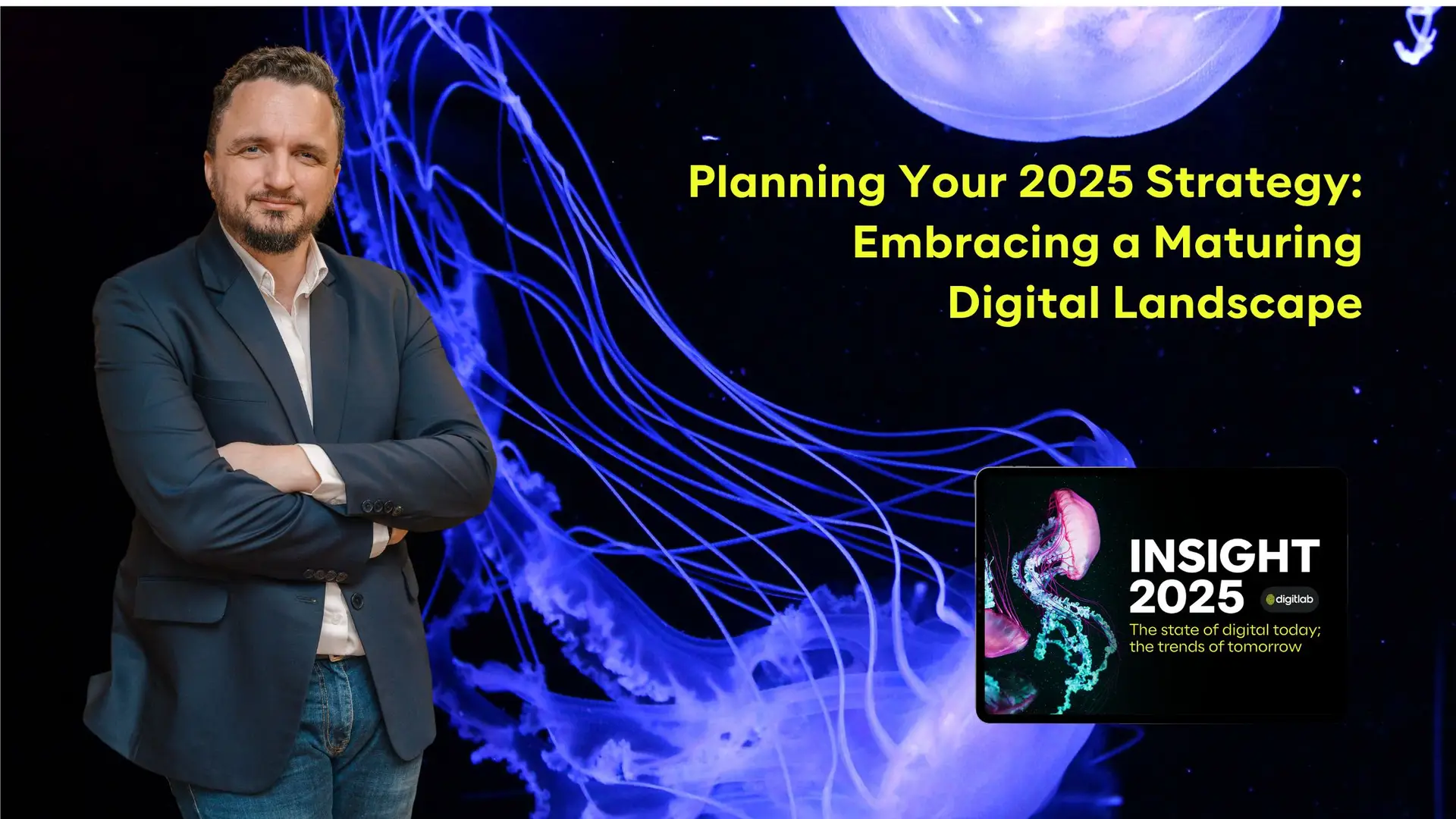We’re proud to wrap up our Insight 2025 series with a compelling contribution from Mike Saunders, CEO of Digitlab. In his article, Mike explores how the evolving nature of digital marketing success demands a shift in focus. With insightful trends and actionable strategies, he highlights the balance between financial returns and fostering customer loyalty as the cornerstone of future-proof strategies. Dive into Mike’s expert advice and prepare to align your 2025 plans with the maturity of the digital age.
As we look to 2025, the way organisations measure digital success is evolving, and these shifts offer valuable insights for planning next year’s strategies. Insights from Insight 2025: The State of Digital reveal a profound change in how companies define success. Today, effective digital marketing isn’t just about metrics like clicks and conversions; it’s about balancing financial returns and fostering long-term customer loyalty.
Organisations are moving away from a purely transactional approach, embracing customer-centric metrics and rethinking how they evaluate Return on Investment (ROI), customer acquisition, and engagement. This data shows that the digital landscape is maturing, with companies adopting a more balanced, relationship-focused view of success.
So, what does this mean for your 2025 strategy? Here’s a breakdown of the trends and metrics that matter most as you prepare for the coming year.
Prioritise ROI and Revenue Attribution
In 2025, digital leaders will prioritise demonstrating a clear link between digital investments and financial impact. Nearly 65% of organisations consider ROI a core metric, emphasising digital’s role as a strategic growth driver. By focusing on ROI and revenue attribution, businesses can ensure that their digital efforts contribute meaningfully to the bottom line.
Strategic Tip: Invest in analytics tools that accurately attribute revenue to digital channels. This capability will help you make data-backed decisions on budget allocation, ensuring that each dollar invested is tied to measurable outcomes. For planning, this means tightening your focus on campaigns that directly impact revenue and cutting back on initiatives that don’t yield significant returns.
Balance Acquisition Costs with Customer Lifetime Value
While lead generation and Customer Acquisition Cost (CAC) remain essential, companies are increasingly mindful of balancing these metrics with Customer Lifetime Value (CLTV). The goal is shifting from merely acquiring new customers to customers offering long-term value. By reducing acquisition costs and increasing CLTV, you can maximise profitability and drive sustainable growth.
Strategic Tip: In your 2025 strategy, consider a dual-metric approach by pairing CAC with CLTV. This combination will help you assess the actual value of your acquisition efforts. Revisit your target audience profiles and prioritise those segments that yield the highest CLTV, ensuring that your marketing spend goes toward attracting customers who will provide ongoing value.
Integrate Customer-Centric Metrics: Satisfaction and Engagement as Key Indicators
The focus on customer-centric metrics—satisfaction, social media engagement, and retention—reflects a maturing approach where organisations value relationship-building alongside transactions. By tracking satisfaction and engagement, companies can foster loyalty, build brand affinity, and cultivate a customer base that returns for more.
Strategic Tip: In 2025, incorporate customer-centric success measures into your KPIs. Include metrics such as Net Promoter Score (NPS), social media engagement rates, and customer feedback loops to understand how satisfied and engaged your customers are. Set specific goals for these metrics, and ensure that your content, service, and outreach strategies align with fostering customer loyalty and satisfaction.
View Engagement and Visibility Metrics as Supporting Indicators
Metrics like traffic sources, search engine rankings, and email open rates still play a valuable role, but they’re no longer the defining measures of success. In 2025, treat these as supporting metrics that indicate reach and visibility rather than ultimate outcomes. They can provide insight into which channels drive engagement and how your brand is perceived, but they shouldn’t be the only metrics guiding your strategy.
Strategic Tip: Use visibility metrics to inform your strategy, not define it. Let these metrics guide your understanding of which channels are most effective for brand awareness, and then leverage this insight to enhance other performance metrics. For example, if specific social platforms drive high engagement but low conversion, focus on using those platforms for brand-building and community engagement rather than direct sales.
Elevate Revenue Attribution to Track Direct Financial Impact
Revenue attribution is becoming central to digital marketing, with over 56% of businesses tracking online sales revenue from digital channels. As digital becomes a significant contributor to business growth, measuring the direct financial impact of digital channels will become increasingly critical. Revenue attribution highlights digital’s role in driving sales and reinforces the importance of data-driven decision-making in planning.
Strategic Tip: To maximise revenue attribution, refine your data tracking and reporting systems by 2025. Use revenue attribution tools that help connect specific digital activities to sales outcomes, giving you a clear picture of what’s working and what’s not. Set quarterly revenue goals for each channel and regularly assess which campaigns contribute most to revenue growth.
Take a Balanced Approach to Success Measurement
In 2025, the most successful digital strategies will blend performance metrics with customer-focused measurements. This combined approach—where businesses value financial returns and customer relationships—reflects a more mature view of digital success.
Strategic Tip: Create a balanced scorecard for your 2025 strategy, including financial and customer-centric metrics. This will allow you to evaluate success holistically and ensure that your digital strategy aligns with broader business goals. Regularly revisit your scorecard to measure progress and make adjustments, maintaining an agile approach that allows you to respond to changing market conditions and customer needs.
Final Thoughts: Building a Future-Proof Digital Strategy
The evolution captured in Insight 2025: The State of Digital tells a powerful story about the maturity of digital marketing. Companies are no longer content with surface-level metrics; they seek more profound insights into customer relationships, ROI, and revenue attribution. As you plan your 2025 strategy, consider how you can balance these metrics to drive both immediate results and long-term loyalty.
Success in the coming year will mean more than just boosting numbers. It will require cultivating meaningful connections with customers, aligning digital investments with revenue goals, and embracing a data-driven approach that values financial and relational outcomes. Adopting this balanced view will strengthen your digital strategy and position your brand as a resilient leader in a continually evolving digital world.
You can read more from our other contributors and download the full report here: https://digitlab.co.za/digital-trends-report/






